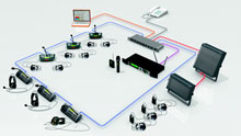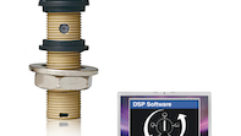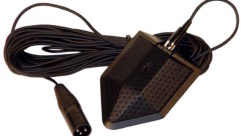
Astatic GN15VPD
Jan 1, 2008 12:00 PM,
By John McJunkin
Continuously variable polar pattern sets gooseneck mic apart.

There is no shortage of gooseneck microphones available for use in installed applications, and most of the offerings out there are good products with numerous attributes that would attract a contractor. I spent time with the Astatic GN15VPD, which is part of a line of miniature gooseneck mics the company makes. In many ways, this condenser mic is very similar to the offerings of other manufacturers. It’s a dual-flex mic, which makes exacting placement easy. It is situated in a desk stand with a programmable switch and an LED indicator. It is RF resistant, and the cable can be configured to emanate from the bottom — or the rear — of the base. These are attributes that many goosenecks exhibit.
The one big thing that distinguishes this mic from others is its continuously variable polar pattern. I own and use numerous mics that make multiple patterns available, and I’m familiar with mics that have continuously variable patterns, but really only in the world of recording and/or live-sound reinforcement. This is the first commercial installation mic I’ve ever encountered with a continuously variable pattern. I find this characteristic to be very welcome and very useful, and I’ll detail why I feel that way.
First, let’s get into the physical attributes of the mic. The GN15VPD is 15in. in length from the bottom of the base to the tip of the mic (and the GN20VPD is — guess what — 20in. long). The lower gooseneck actuation is 5/16in. in diameter, the rigid metal tube comprising the middle of the mic’s body is 3/8in. in diameter, and the upper gooseneck actuation is 1/4in. in diameter. The microphone is 7/16in. in diameter and 1 5/16in. in length. The lower end of the mic body is a cone that tapers upward from the base. The connector that mates the mic with the base is a gold-plated, 1/8in. tip-ring-sleeve mini-jack pair. The mic body actually screws into the base with brass threads, ensuring that the mic is solidly attached from both physical and electrical standpoints. The mic body is formed of metal with a nice black matte finish.
The mic’s base is also formed of black matte-finished metal, and it has a nice hefty, solid feel. The base’s diameter is 4 1/2in., and it is the face upon which the switch, indicator LED, and mic receptacle are situated. It is angled slightly down, which tilts the microphone toward the speaker and creates a nice visual line-of-sight of the switch and LED. Under the base is the mic’s TB4M connector, which is recessed into a well in the panel. There are six rubber feet, and a four-position DIP switch that determines power-up and switch-logic options. Finally, there is a dial that determines polar pattern. Astatic includes a black security label that can be placed over the switch and the dial in order to preserve settings. A 30ft. cable, which also serves as the mic’s TA4F-to-XLR adapter, is included, along with a foam windscreen.
The mic’s DIP switch has five options. The first is push to talk, a momentary mode in which depressing the switch activates the mic, closes the mic’s logic output, and turns on the LED. Next, push to mute reverses everything that push to talk does: muting the mic, opening the logic output, and extinguishing the LED. The third option is power up on, in which the initial application of phantom power activates the mic, closes the logic output, and turns on the LED; and touching the switch toggles the mute, logic output, and LED. The fourth mode is power up off, which is the reverse of power up on, with mic muted, logic output open, and LED off upon power application. In this mode, the switch toggles those three attributes to their alternate conditions. The fifth and final mode is remote mode, in which the LED lights if the logic input is grounded, the logic output closes if the switch is pressed, and the audio always remains unmuted. This array of options should cover just about every possible scenario necessary, including the use of automatic mixers, teleconferencing systems, and other external control systems.
We finally get down to the feature that really distinguishes this mic from the others: a continuously variable pattern. As the dial on the bottom of the base is rotated clockwise, the pattern progresses from wide-open omnidirectional to cardioid to supercardioid to hypercardioid to figure eight. As you may be aware, the off-axis lobe of a hypercardioid pattern is substantially larger than the lobe of a cardioid pattern, and pushing the phase relationship beyond hypercardioid causes that lobe to continue growing until you have a full-blown figure eight with equal lobes on both sides. Before ever plugging the GN15VPD in to hear it, my presumption was that listening to the mic’s output and changing the pattern while a subject speaks would produce an optimal pattern that maximizes the level of the subject, while minimizing clarity-reducing room ambience.
I put on a pair of headphones and connected the mic. Upon the application of phantom power, the mic woke up in power up on mode, as Astatic said it would. As I moved the dial around, listening to my subject’s voice, I discovered that my presumption was correct. The variable pattern allowed me to achieve the perfect compromise. If the subject is an animated speaker, a super-tight cardioid may not work well, with the speaker bobbing and weaving in and out of the pattern, but an omni pattern would decrease clarity too much. This mic allowed me to nail the best possible middle ground. Proximity effect is quite pronounced in this mic, with the figure-eight pattern substantially enhancing the low end. That enhancement tapers off as the pattern is shifted toward omnidirectional. And this is not problematic in the least — just something of which you’ll want to be aware. Also, Astatic integrated a 12dB/octave high-pass filter with a cutoff frequency of 80Hz, so this mic is not going to capture a lot of deep low end anyway — perfectly appropriate for a boardroom or podium mic like this.
I found the mic to exhibit good fidelity otherwise, with a relatively flat response across the spectrum, and it has the resolution you’d expect from a condenser mic. The self-noise is low, and there was no discernible distortion whatsoever. Astatic says the mic is capable of taking SPLs up to about 120dB with only 1 percent THD, and that’s perfectly appropriate for a mic that will be used primarily in business or governmental applications. The bottom line is that even without the continuously variable polar pattern, this is a nice mic. The addition of that powerful extra makes it very well worth consideration. When you specify a mic for an installation, you don’t even have to think about the pattern in the case of the Astatic GN15VPD — just dial up the pattern you want. I would definitely recommend taking a listen to this mic.
PRODUCT SUMMARY
Company: Astatic Commercial Audio www.astaticinstalled.com
Product: GN15VPD
Pros: Continuously variable pattern facilitates optimization.
Cons: None.
Applications: Governmental, institutional, and business.
Price: $398
SPECIFICATIONS
Polar pattern: Continuously variable
Frequency response: 80Hz to 18kHz
Sensitivity: 16mV/Pa
Impedance: 120Ω
Self-noise: 29dBA
Maximum SPL: 120dB, 1% THD, 1kHz
Power requirements: P12, P24, P48, 4mA
Connector: TB4M-type
Polarity: Positive pressure on diaphragm corresponds to positive voltage on pin 1 relative to pin 2 at TB4M-type connector.
Logic output: NPN open collector, 30V, 50mA, max
Logic input: 40K pull-up resistor to 1.3V
John McJunkinis the principal of Avalon Podcasting in Chandler, Ariz. He has consulted in the development of studios and installations and provides high-quality podcast production services.










